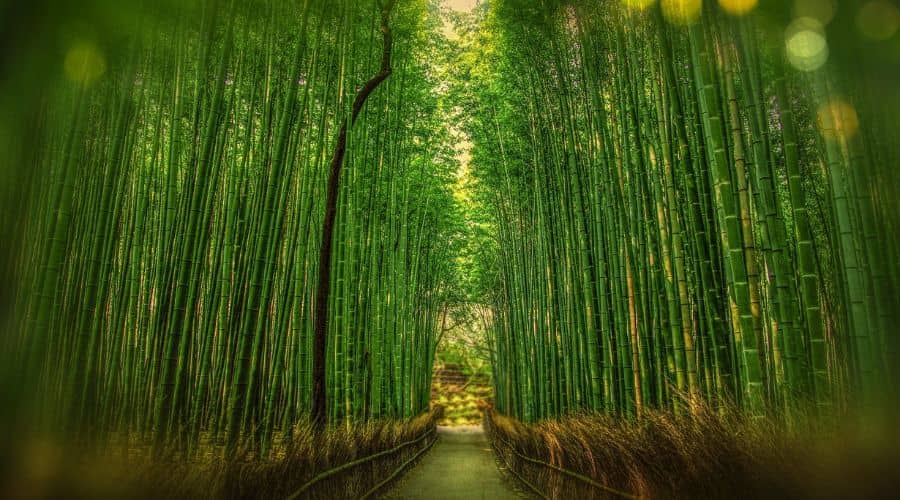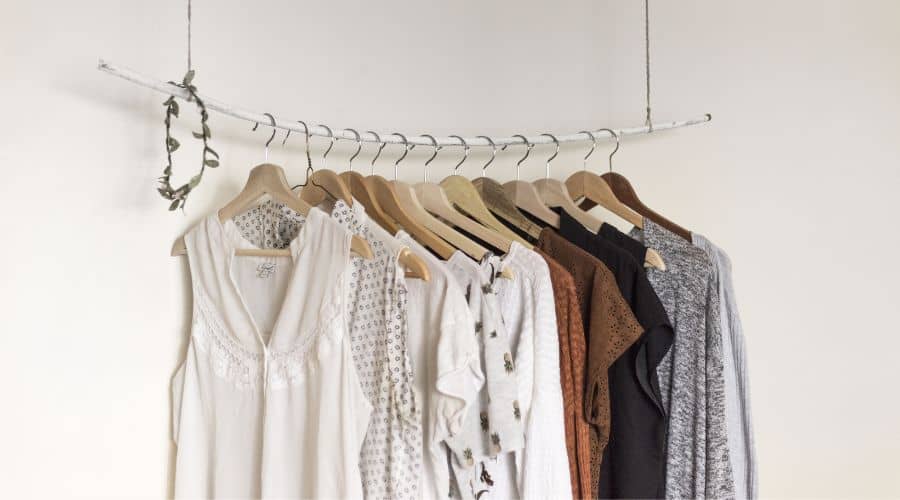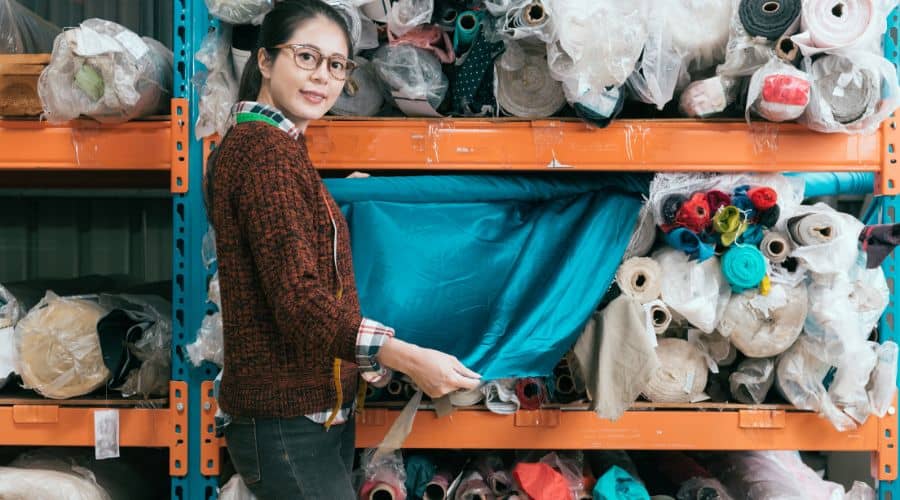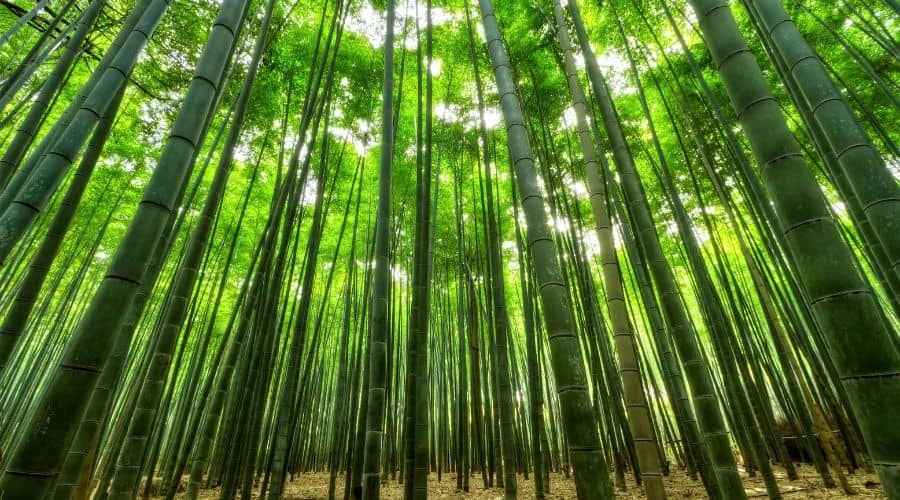
In a world of fast fashion and a growing textile waste problem, bamboo fabric has been hailed as a miracle solution to the environmental issues caused by the fashion industry. Bamboo grows faster than any other plant and it does this while requiring little water and no fertilizer or pesticide. It absorbs more carbon dioxide and releases more oxygen than similar plants.
Bamboo is regenerative so harvesting it doesn’t have the same ecological impact as harvesting trees. These and more reasons are making bamboo’s popularity in the eco-friendly fashion world grow by the day.
What Is Bamboo Fabric Used For?
Bamboo fabric is mainly used in textiles for a range of products including bamboo clothing, bamboo pajamas, bamboo underwear, activewear, towels and bedding.
Bamboo is one of the most popular fabrics. It is durable and resilient, lasting longer than other types of fabrics. Bamboo fabric is also incredibly soft, silky, and luxurious providing utmost comfort. For those with sensitive skin, bamboo fabric is a lifesaver. The fibers do not irritate the skin and they’re more gentle than man-made fabrics.
 Bamboo fabric is mainly used in textiles such as clothes and bedding.
Bamboo fabric is mainly used in textiles such as clothes and bedding.
When compared to cotton and polyester, the bamboo fabric was found to be stronger with better moisture absorption, and moisture-wicking properties. It is breathable and thermo-regulatory thanks to the cross-sectional fibers. Air filters through, eliminating the build-up of heat. It also acts as an insulator. Bamboo fabric is also stretchy which is why it’s used to make activewear and underwear. It is odour-resistant thanks to its antibacterial and antifungal properties.
Bamboo fabric has natural UV protection properties. You can get up to UPF 50+ protection from bamboo clothes. Finally, bamboo fibers are biodegradable. Once discarded, the material will simply break down.
Why Is Bamboo Fabric Popular?
Bamboo fabric has become very popular as the material is soft, comfortable, durable, and versatile. You can make any type of bamboo fiber clothing whether it’s bedding or underwear or bamboo t-shirts. There is no limit to what bamboo fibers can do. The gentle, antibacterial, and antifungal material is great for people with sensitive, allergic, or eczema-prone skin. Not to mention, the clothes drape nicely on your skin. You get to feel good and look good at the same time.
Bamboo fabric’s sustainability has a lot to do with its popularity. People care about the environment and they want to do their part in preserving it. This means using eco-friendly bamboo products in their everyday lives. Bamboo’s reputation as an eco-friendly plant makes it a great alternative to synthetic fibers.
What is Bamboo Fabric Made From?
There are several ways to make bamboo fabric from bamboo. The first is made through a mechanical process. It involves combing out bamboo fibers and turning them into threads. This results in a fabric called bamboo linen.
The process is quite labor-intensive and results in a fabric that feels uncomfortably rough. Bamboo linen is not very popular as a result and only makes up a small portion of the bamboo fabric market.
The second method of processing bamboo fibers uses chemicals to make bamboo rayon. This highly chemically intensive process involves dissolving bamboo in a chemical solution to produce a pulpy, syrupy substance. The substance is pushed through tiny holes into a solution of sulfuric acid which congeals the fibers. Bamboo fibers are then spun into threads and into the silky-soft fabric that bamboo clothing is known for. The chemicals used to make bamboo rayon are hazardous to both the environment and humans. Recently, the processors have made improvements in chemical management and waste treatment.
There’s a similar fabric called lyocell. It is made in the same way as rayon but in a closed-loop system that reuses and recycles the chemicals. Bamboo clothes made through the lyocell process are branded Monocel.
 There are several ways to make bamboo fabric.
There are several ways to make bamboo fabric.
Is Bamboo Fabric Sustainable?
Bamboo fabric is one of the most sustainable materials if manufactured under the right conditions. Let’s take a look at the environmental benefits of using bamboo fabrics.
Environmental Benefits Of Bamboo Fabric
Bamboo cleans the air by absorbing more carbon dioxide than similar clusters of trees. Thanks to the density of bamboo forests, bamboo releases 35% more oxygen than trees. Bamboo requires less water and energy to grow compared to other plant-based fibers. There’s no need to irrigate bamboo plantations. The plants do not require pesticides or fungicides because they produce antibacterial and antifungal agents.
Bamboo can reclaim degraded lands and ravines thanks to its root system and fast growth rate. Harvesting bamboo is more sustainable than other plants. Bamboo grows very quickly making it a high-yield crop. It is also regenerative meaning it can regrow without the need for replanting. As such bamboo is a renewable resource.
 Bamboo requires less water and energy to grow compared to other plant-based fibers.
Bamboo requires less water and energy to grow compared to other plant-based fibers.
Lastly, bamboo fabric is biodegradable. It can safely be disposed of into landfills or incinerated without harming the environment.
Read more about interesting bamboo facts.
Environmental Issues With Bamboo Fabric
Just because bamboo has many benefits doesn’t mean that there aren’t environmental concerns. Commercial cultivation of bamboo doesn’t have the best impact on the environment. Large areas are cleared to make way for bamboo plantations. These plantations only grow bamboo, removing any other plant that could grow alongside the bamboo. This impacts organisms such as insects and fungi that rely on diversity in the ecosystem for survival.
Furthermore, the only large-scale commercial farming of bamboo is happening in China. This means that most bamboo products are shipped from China. Shipping over great distances leaves a carbon footprint so it is quite hard for brands to claim a net-zero carbon status.
Bamboo’s eco-friendly status takes its biggest hit during the processing stage. The chemicals used are very toxic and quite harmful to the nervous and reproductive systems of the body. Chlorine compounds and volatile organic compounds (VOCs) are released into the air while waste from bleaching factories is dumped into waterways.
Thankfully in the decades since bamboo first exploded into popularity, there have been newer processes that curb the environmental harm. Closed-loop systems prevent the dumping of 99% of the chemicals used. Safer solvents such as acetic acid are used in place of toxic ones.
There has also been growing pressure on manufacturers in China to introduce transparency in their production. Look for certifications such as Oeko-Tex, Soil Association, SKAL, and KRAV to know whether or not the manufacturing process is good for the environment and workers.
Types of Bamboo Material. What Is the Best Option?
There are 3 types of bamboo material. The first is conventional bamboo rayon.
Rayon
Rayon is made from cellulose and requires chemicals to produce the fibers. The most common process melts the cellulose, before dissolving the melted cellulose in a caustic soda. The cellulose is then regenerated using a spinneret. Because there isn’t a closed-loop system, the water generated is then dumped back into the environment. While bamboo viscose is better for the environment than other rayons, it’s still the dirtiest method to make bamboo fabric.
The second method is the lyocell process.
Lyocell
Lyocell is made in a similar way to bamboo viscose but in a closed-loop system. The water and chemicals used are never released but instead recycled and reused. This process is usually considered a compromise. It’s not the greenest option but it’s also not the dirtiest.
The third method is the greenest. This method is the process of making bamboo linen.
Bamboo linen
Bamboo linen is made mechanically by shredding bamboo and turning it into mash using natural enzymes. The natural fibers are then combed out and spun into yarn. Bamboo linen absorbs dye pretty easily adding to its eco-friendly credentials. Unfortunately, it is too expensive to be done at an industrial level.
Final Thoughts On Bamboo Fabric
Is bamboo sustainable? Yes, bamboo fabric is more sustainable than other plant-based textiles. But like many eco-friendly products, it’s difficult to make it 100% safe for the environment. You have to balance consumer needs and environmental concerns.
The most eco-friendly process to make bamboo fabric costs the most money and turns away consumers due to its rough texture. The lyocell fabrics are the best options for now. Don’t forget to do your research and choose carefully.

![]() Jamie - Cofounder
Jamie - Cofounder
Hi, I hope you enjoyed reading this article.
If you are looking for more ways to live an eco-conscious lifestyles, then check out our complete guide here.
Thanks for stopping by - Jamie


